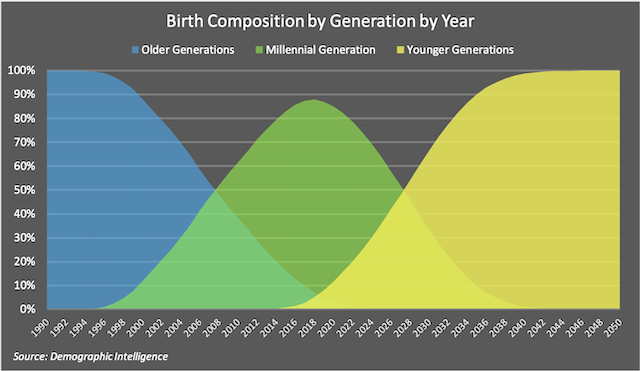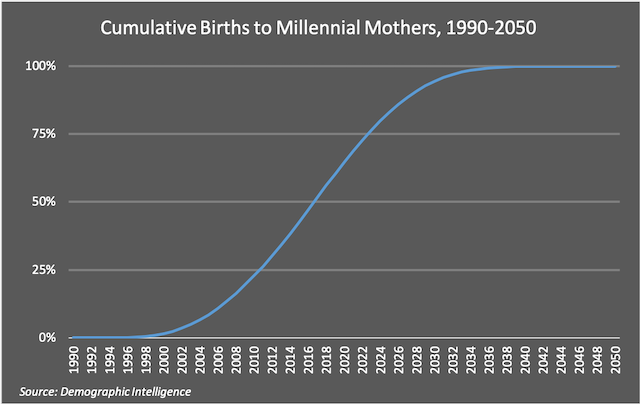Highlights
- Demographic Intelligence projects that the proportion of births born to Millennial women will fall below 75% of all births in 2023, below 50% of all births in 2028, below 25% of all births in 2032, and below 10% of all births in 2035. Post This
- More than half of all children that will eventually be born to Millennial mothers (56%) have already been born as of 2018. Post This
Several news stories have covered the delay in childbearing among Millennials (see here, here, and here). Some Baby Boomer parents even wonder when or if they will have grandchildren. It is true that Millennials are on track to have fewer children than previous generations and fertility rates are currently at an all-time low. Moreover, Millennials are indeed waiting longer to become parents, and the average age at first birth has risen by more than two full years in the past two decades. However, despite these delays, Millennial women continue to have babies, and more than half of the children that will eventually be born to Millennial women are already here.
There are about 40 million Millennial women in the United States (defined as those born between 1981 and 1998.)1 Across their lifespan, these women will give birth to approximately 75 million children. The first Millennials gave birth at age 10 in 1991, while the last Millennials will give birth in their early fifties, sometime around 2050 (assuming there are no major advancements in reproductive technologies that allow women to give birth at much older ages). However, these ages represent the extreme edges of the reproductive years.
The following chart shows the composition of births by generation from 1990 to 2050. Between 1991 and 1996, when the oldest Millennials were still only 15 years old, Millennials mothers gave birth to 1% or less of all children that were born. In the year 2000, when the oldest Millennials were 19, mothers in their generation gave birth to more than 10% of all children born that year (the final total was 11.8%). From there, the percentage of all children born in a year to Millennial mothers steadily increased, reaching more than 25% in 2003, more than 50% in 2008, and more than 75% in 2013 before peaking at 88% in 2018.

In 2018, Demographic Intelligence estimates that approximately 5% of all births were to women younger than the youngest Millennials, and 7% of births were to women older than the oldest Millennials. Though 2018 was the peak for the percent of children born to Millennial mothers, the highest number of actual births most likely occurred in 2017, with 3.38 million. Because total births are expected to decline, total births to Millennials are set to decline, as is the proportion of births to all Millennial women. From now on, Demographic Intelligence projects that the proportion of births born to Millennial women will steadily decline, falling below 75% of all births in 2023, below 50% of all births in 2028, below 25% of all births in 2032, and below 10% of all births in 2035.
Another way to look at Millennial births is to examine when Millennial women themselves have given birth compared to other Millennials, not other generations. As a generational cohort, Demographic Intelligence predicts that Millennial women will give birth to approximately 75 million children (assuming current birth and immigration trends continue for the foreseeable future). The chart below shows when Millennial women will give birth to these roughly 75 million children.

In the 1990s, few Millennial women were of childbearing age, and some of them were not even born yet since the final year of Millennials being those born was 1998. As a result, very few of the children that would be born to this generation were born in the 1990s. In fact, by the end of 1999, Millennial women had given birth to less than 650,000 children (less than 1% of the anticipated 75 million total). However, by the end of 2000, when the oldest Millennials mothers were 19 years old, Millennial women had given birth to about 1.1 million children, but still only about 1.5% of the total number of children they are estimated to have. By 2006, these mothers had given birth to over 8 million children, just over 10% of all the expected births, and it quickly increased from there to just under 20 million children in 2011 (or 19.7 million), which was more than one-fourth of the children they are estimated to ultimately have (26%). Sometime in the latter half of 2017, Millennial women reached the expected midpoint, having given birth to approximately 37.5 million children. What does this mean?
Demographic Intelligence estimates that more than half of all children that will eventually be born to Millennial mothers (56%) have already been born as of 2018. Though Millennial women will give birth to the majority of children born in any given year until around 2027, more than half of their children have already been born. Moreover, by 2023, more than three out of four children who will eventually be born to Millennial mothers will have already been born, and by 2028, we estimate more than 90% of the children of Millennial mothers will have been born.
The largest cohorts of Millennial women are currently in their peak childbearing years (ages 25-34). However, all peaks eventually turn to valleys, and we estimate that Millennial women are now on the downhill slope of that peak. Even though the younger generation only gave birth to about 5% of all children in 2018, their numbers will grow and they will slowly begin to overtake Millennials. That means, according to our estimates, that 10 years from now, in 2028, more than half of all births will occur to women younger than the youngest Millennials.
Samuel Sturgeon is president of Demographic Intelligence, a full-service demographic consulting firm that specializes in fertility and marriage projections.
1. There is no standard definition of what birth cohorts are considered to be part of the Millennial generation. Depending on the report you read, Millennials could be born as early as 1977 and as late as 2005. Pew and others have tried to standardize the years, but as of yet there is no consensus. The most common starting year is 1981, so we have chosen to use that as our starting year. For the ending year, 1996 (Pew) and 2000 (several others) seem to both be popular choices. For this report, we elected to split the difference and choose 1998 as the final year for Millennials.











